| Major Groups > Gilled Mushrooms > Pale-Spored > Collybioid> > Xeruloid > Hymenopellis megalospora |

|
Hymenopellis megalospora [ Basidiomycota > Agaricales > Physalacriaceae > Hymenopellis . . . ] by Michael Kuo To the naked eye, Hymenopellis megalospora is a dead ringer for several other xeruloid mushrooms, including Hymenopellis incognita and pale, small forms of Hymenopellis furfuracea. This means you will probably need a microscope, the ability to conduct mating studies in a mycological laboratory, or equipment for DNA studies in order to identify it with certainty--unless you are willing to dry and preserve your specimen for a few years; Hymenopellis megalospora appears to be the only North American xeruloid mushroom species that develops bright orange gills when stored in a herbarium. However, the orange color takes a few years to develop, and apparently fades to yellow within about 50 years (see Redhead and collaborators 1987 for details). The easiest course is to study Hymenopellis megalospora with a microscope. Its large spores are decidedly lemon-shaped, and feature finely dimpled surfaces; its cheilocystidia have swollen, capitate ends; and its pileipellis features hyaline, thin-walled pileocystidia. Xerula megalospora is a synonym. Older field guides often combined Hymenopellis megalospora with what have since been designated as separate species of Hymenopellis, in treatments of "Collybia radicata," "Oudemansiella radicata," and "Xerula radicata." Description: Ecology: Saprobic on the deadwood of hardwoods; occasionally growing directly from very well decayed logs and stumps, but more commonly attached to buried deadwood near stumps, appearing terrestrial; late spring through fall; widely distributed east of the Rocky Mountains. The illustrated and described collections are from Illinois. Cap: 2-5 cm; bell-shaped to sub-conic when young, becoming broadly bell-shaped to broadly convex or nearly flat in age; bald; sometimes somewhat radially wrinkled; sticky to greasy when young, but soon dry; color variable, ranging from dark grayish brown to dull yellowish brown--or buff to nearly white, with or without a darker center. Gills: Attached to the stem by means of a notch and a tiny tooth that runs down the stem; distant or nearly so (occasionally close); white; short-gills frequent. Stem: 4-16 cm long above ground; 0.5-1.5 cm thick; tapering to apex; bald, or finely fibrillose with brownish fibrils that break up in age to form stripes and chevrons; white; with a short, quickly tapering tap root extending up to 4 cm underground; the root staining reddish brown. Flesh: White; thin; unchanging when sliced. Odor and Taste: Not distinctive. Chemical Reactions: KOH on cap surface negative. Dried Specimens: Gills of dried specimens become bright orange after several years in storage. Spore Print: White. Microscopic Features: Spores 15-21 x 8-12 µ; limoniform to amygdaliform at maturity; finely dimpled or pitted; inamyloid; hyaline in KOH. Hymenial elements of herbarium specimens often with pinkish orange to orange contents in KOH. Pleurocystidia widely cylindric to subutriform; thin-walled; hyaline; smooth; 70-110 x 10-22 µ. Cheilocystidia usually capitate to subcapitate but sometimes clavate or fusiform; up to 80 x 15 µ. Pileipellis hymeniform and somewhat gelatinized; pileocystidia frequent, thin-walled, hyaline, up to 90 x 30 µ. REFERENCES: (Clements, 1896) R. H. Petersen, 2010. (Redhead, Ginns & Shoemaker, 1987; Phillips, 1991/2005; Petersen & Methven, 1994; Barron, 1999; Roody, 2003; McNeil, 2006; Miller & Miller, 2006; Petersen & Hughes, 2010; Kuo & Methven, 2014.) Herb. Kuo 05169505, 05160801, 06070802, 06270806, 07120805, 07200802. This website contains no information about the edibility or toxicity of mushrooms. |
© MushroomExpert.Com |
|
Cite this page as: Kuo, M. (2014, November). Hymenopellis megalospora. Retrieved from the MushroomExpert.Com Web site: http://www.mushroomexpert.com/hymenopellis_megalospora.html |
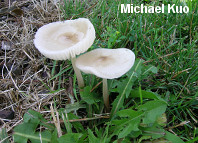
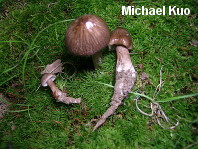
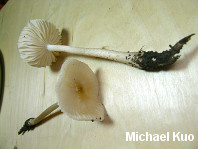
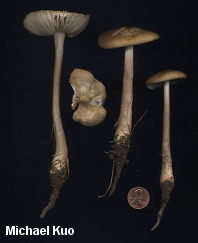
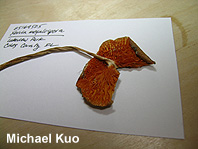
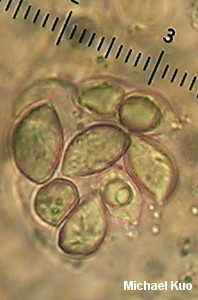 Spores (units x 2.5)
Spores (units x 2.5)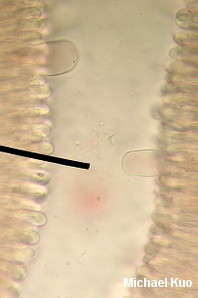 Pleurocystidia
Pleurocystidia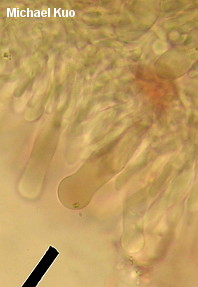 Cheilocystidia
Cheilocystidia